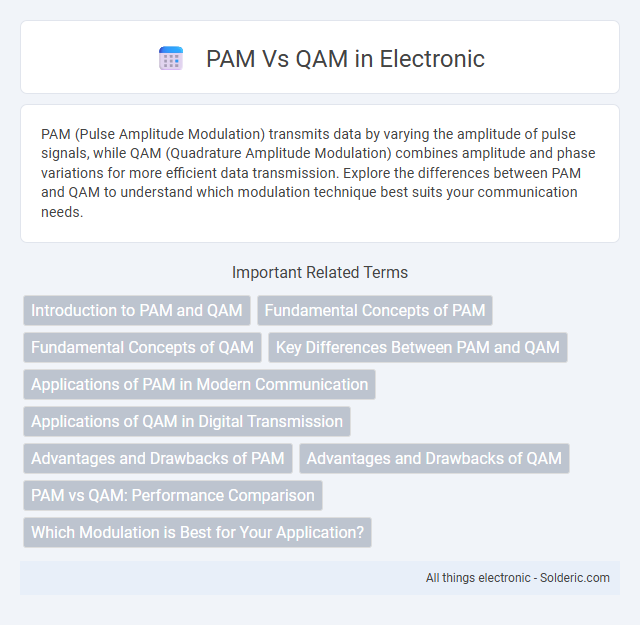PAM (Pulse Amplitude Modulation) transmits data by varying the amplitude of pulse signals, while QAM (Quadrature Amplitude Modulation) combines amplitude and phase variations for more efficient data transmission. Explore the differences between PAM and QAM to understand which modulation technique best suits your communication needs.
Comparison Table
| Feature | PAM (Pulse Amplitude Modulation) | QAM (Quadrature Amplitude Modulation) |
|---|---|---|
| Modulation Type | Amplitude variation of pulses | Combination of amplitude and phase modulation |
| Signal Components | Single dimension (amplitude) | Two dimensions (in-phase and quadrature) |
| Bandwidth Efficiency | Lower | Higher |
| Complexity | Simple implementation | More complex transmitter and receiver |
| Applications | Digital communications, data transmission in baseband | Digital TV, cable modems, wireless communications |
| Noise Sensitivity | Moderate, affected by amplitude noise | Higher, due to phase and amplitude noise |
| Data Rate | Lower data rates compared to QAM | High data rates, efficient spectral use |
Introduction to PAM and QAM
Pulse Amplitude Modulation (PAM) encodes data by varying the amplitude of pulse signals in discrete levels, making it fundamental in digital communication systems. Quadrature Amplitude Modulation (QAM) combines amplitude modulation of two carrier waves shifted in phase by 90 degrees, enhancing data transmission efficiency by encoding information in both amplitude and phase. These modulation techniques are critical in optimizing bandwidth and improving signal robustness in modern telecommunication networks.
Fundamental Concepts of PAM
Pulse Amplitude Modulation (PAM) encodes data by varying the amplitude of discrete pulses, representing information through distinct signal levels transmitted over time. It forms the basis for more complex schemes like Quadrature Amplitude Modulation (QAM), which combines amplitude and phase variations for higher spectral efficiency. Your communication system relies on PAM's simplicity and direct amplitude mapping to achieve fundamental signal modulation in digital transmission.
Fundamental Concepts of QAM
Quadrature Amplitude Modulation (QAM) combines both amplitude and phase variations to encode data, enabling higher spectral efficiency compared to Pulse Amplitude Modulation (PAM), which only varies amplitude. QAM modulates two carrier waves shifted by 90 degrees (in-phase and quadrature components) to represent multiple bits per symbol, increasing data throughput. The constellation diagram of QAM shows distinct points representing unique symbol combinations, directly impacting error performance and bandwidth utilization.
Key Differences Between PAM and QAM
Pulse Amplitude Modulation (PAM) encodes data by varying the amplitude of pulses in a single dimension, while Quadrature Amplitude Modulation (QAM) combines amplitude modulation with phase modulation to encode data in two dimensions, enhancing data throughput. PAM is simpler but more susceptible to noise, making it suitable for lower data rates, whereas QAM's multidimensional encoding supports higher data rates and more efficient bandwidth usage. Your choice between PAM and QAM depends on factors like signal quality, bandwidth availability, and required data rate.
Applications of PAM in Modern Communication
Pulse Amplitude Modulation (PAM) is widely used in modern communication systems such as Ethernet and digital subscriber lines (DSL) due to its simplicity and efficiency in encoding data over wired channels. PAM transmits data by varying the amplitude of pulses, making it suitable for applications where bandwidth efficiency and signal integrity are crucial. Your network devices benefit from PAM's robust performance in baseband data transmission and optical fiber communication.
Applications of QAM in Digital Transmission
Quadrature Amplitude Modulation (QAM) is extensively used in digital transmission systems such as cable modems, digital television, and wireless communication due to its ability to combine amplitude and phase modulation for higher data rates. It efficiently supports high spectral efficiency in systems like 4G LTE and Wi-Fi standards by encoding multiple bits per symbol, enabling increased bandwidth utilization. Advanced QAM schemes, including 64-QAM and 256-QAM, are critical in modern broadband networks for achieving high-speed data transfer and maintaining robust signal quality over noisy channels.
Advantages and Drawbacks of PAM
Pulse Amplitude Modulation (PAM) offers simplicity in implementation and lower bandwidth requirements compared to Quadrature Amplitude Modulation (QAM), making it suitable for baseband transmission systems and short-distance communication. However, PAM is more susceptible to noise and distortion due to its reliance on amplitude variations alone, which limits its performance in noisy environments and reduces spectral efficiency. Despite these drawbacks, PAM remains advantageous in applications where cost and complexity are critical constraints, such as in digital signaling and Ethernet communication systems.
Advantages and Drawbacks of QAM
Quadrature Amplitude Modulation (QAM) offers higher spectral efficiency than Pulse Amplitude Modulation (PAM) by combining amplitude and phase modulation to transmit multiple bits per symbol, making it ideal for high data rate communications. Your system benefits from QAM's ability to maximize bandwidth usage, but it also faces increased complexity in both transmitter and receiver design, as well as greater susceptibility to noise and signal distortion. Choosing QAM requires balancing these performance gains against the demands of more sophisticated error correction and signal processing techniques.
PAM vs QAM: Performance Comparison
Pulse Amplitude Modulation (PAM) offers simpler implementation with fewer signal levels, but Quadrature Amplitude Modulation (QAM) provides higher spectral efficiency by combining amplitude and phase variations, enabling more bits per symbol. QAM generally outperforms PAM in noisy environments due to its enhanced error resilience and better utilization of bandwidth. Your choice between PAM and QAM depends on the balance between system complexity, bandwidth availability, and required data rate performance.
Which Modulation is Best for Your Application?
PAM (Pulse Amplitude Modulation) offers simplicity and is ideal for applications requiring lower bandwidth and straightforward implementation, such as basic digital communication systems. QAM (Quadrature Amplitude Modulation) provides higher spectral efficiency and better noise resilience, making it suitable for high-speed data transmission like cable modems and LTE networks. Selecting the best modulation depends on factors like desired data rate, channel conditions, and system complexity, with QAM favored for bandwidth efficiency and PAM preferred for ease of use in lower-demand scenarios.
PAM vs QAM Infographic

 solderic.com
solderic.com